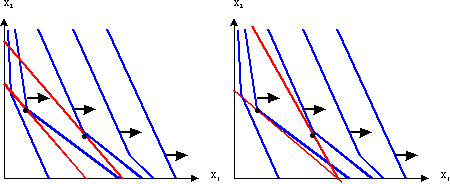Econ 302: Solutions for the Questions about Demand Functions
Question 1:
u1(x1,x2)=1 and
u2(x1,x2)=1/x2. Hence
MRS=-x2. Thus,
MRS=-x2=-p1/p2 and hence,
Thus,
x2=p1/p2, and we already have the
first demand function. The second one can be found by inserting this
demand function in the equation of the budget line
p1x1+p2x2=m. In
particular,
p1x1+p1=m. Thus,
x1=(m-p1)/p1=
m/p1-1. This is the second demand function.
Note that for p1>m, x1<0. This indicates that we have a boundary optimum in those cases. In fact, the correct demand functions for p1>m are x1=0 and x2=m/p2.
Question 2:
- Note that MRS=-1/3. The price ration is -p1/p2=-2/3. Thus, MRS=-p1/p2 never holds. Thus, the first part of the procedure to find an optimum did not work and we must have a boundary optimum). The two intercepts are given by (6,0) and (0,4). Their utilities are 6 and 12, respectively. Thus, (0,4) is optimal.
- Now MRS=-3. The price ration is -p1/p2=-2/3. Again, MRS=-p1/p2 never holds. and we have a boundary optimum). The two intercepts are again given by (6,0) and (0,4). Their utilities are 18 and 4, respectively. Thus, (6,0) is optimal.
- Now MRS=-2/3. The price ration is -p1/p2=-2/3. Thus, MRS=-p1/p2 holds for all consumption choices. As a consequence, all consumption choices on the budget line 2x1+3x2=12 are optimal. Geometrically, the budget line coincides with one indifference curve.
Question 3: The partial derivative are given by u1(x1,x2)=2/x1, and u2(x1,x2)=1/x2. Thus, MRS=-2x2/x1=-p1/p2. Consequently, p1x1=2p2x2 or (1/2)p1x1=p2x2. The equation of the budget line is p1x1+p2x2=m. Substituting (1/2)p1x1 for p2x2 in this equation yields (3/2)p1x1=m, and consequently, x1=2m/(3p1). Similarly, it follows that x2=m/(3p2).
Note that this is the same computation as for the Cobb-Douglas utility function u(x1,x2)=x12x2 in your class notes.
Question 4: u1(x1,x2)=1 and u2(x1,x2)=1/x21/2. Hence MRS=-x21/2. Thus, MRS=-x21/2=-p1/p2. If we take the square on both sides of the equation we therefore get x2=p12/p22. This is already the demand function for good 2. In order to get the demand function for the first good, we insert this in the equation of the budget line p1x1+p2x2=m. Thus, p1x1 + p12/p2 = m. Consequently, p1x1 = m - p12/p2. Dividing both sides by p1 gives the demand function for good 1. Specifically, x1 = (m/p1) - p1/p2.
Note that for m/p1< p1/p2 we get x1<0 which means that we have a boundary optimum. You can check that in this cases the boundary optimum is given by x1=0 and x2=m/p2.
Question 5: Note that the demand for good 2 decreases as income is increased (indicated in the graph on the left). Hence good 2 is an inferior good. Similarly, you can see in the graph on the right that a price increase of good 2 can result in an increase of demand for good 2.
